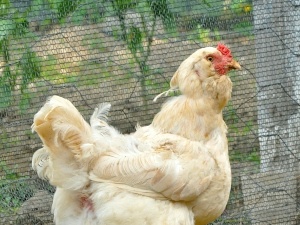
Every living organism can get sick, chickens included. Different types of illnesses can cause different symptoms in chickens, and many of these symptoms will seem quite odd and unusual.
One odd and unusual symptom of a bird illness is yellow pus coming from the bird’s eye. This article explores why this happens and what to do.
Table of Contents
Yellow pus in chicken eye:
The pus produced by chickens and the pus produced by humans is not the same. Chicken pus is quite solid while human pus is more of a thick fluid texture.
Both human pus and chicken pus are cause for concern. If your bird has yellow pus in its eye then this may be why:
Mycoplasma:
This illness is similar to the common cold in humans but it also causes chickens to produce a yellow or white pus at the eye.
Mycoplasma is a bacterial infection caused by the mycoplasma galisepticum (MG) and the M. synoviae (MS) bacteria.
This is a respiratory illness that causes symptoms like swollen eyelids, gasping, coughing, swollen sinuses, blocked sinuses, sneezing, nasal discharge, and varying degrees of respiratory distress.
Birds with weak immune systems, like young birds, old birds, or birds recently recovering from a previous illness are the most at risk when it comes to catching this disease.
The bacteria can be transferred via respiratory droplets produced when the bird coughs or sneezes, it can also be transferred through direct contact between a sick and a healthy bird.
It can also be transferred via the eggs of an infected mother bird to a baby bird in the egg.
What to do:
You’d need to isolate the sick bird as soon as you realize that the bird is sick. Quarantining the sick bird will give it a stress-free space to heal and keeping it away from the rest of the flock will keep it from infecting other birds.
Give this bird its own food and water while it’s in quarantine and make sure that the bird also gets vitamins and minerals, probiotics, and electrolytes while in quarantine.
Doing this will boost the bird’s immune system and help the bird fight off its infection.
Giving the bird antibiotics can sometimes help, these will not eradicate the bacteria but they will reduce the symptoms of the disease in the bird.
Keep other birds from becoming sick by cleaning and disinfecting the chicken coop, replace the bird’s bedding as well.
Aspergillosis:
This is another illness that causes chickens to produce yellow pus, or plaques, in their eyes. This condition usually affects the bird’s respiratory tract but it can also have an effect on your chicken’s brain and eyes.
If aspergillosis does start to affect your bird’s eye, it will cause yellow plaques to form under the bird’s eyelids. These yellow plaques may be what you’re seeing as pus in the eye.
The illness is caused by a fungus, the aspergillus fumigatus fungus, and birds who inhale these spores will contract this illness.
Inhaling a small amount of spores will likely not cause this disease to develop in your bird but inhaling large amounts of the spores will.
Once the spores are inhaled, they will move to different parts of the bird’s body, not only to the bird’s eyes but to the bird’s brain, gastrointestinal tract, skin, liver, muscles, and the kidneys as well.
A bird suffering from this ailment may be asymptomatic until the disease has progressed enough.
This illness not only affects chickens but geese, pheasants, turkeys, ostriches, ducks, canaries, and a variety of wild and captive birds as well.
It usually affects younger birds whose immune systems aren’t very robust but it can also affect birds who are immunocompromised, like old birds, or birds recovering from an illness.
Other symptoms of aspergillosis in chickens include diarrhea, fever, loss of coordination, nasal discharge, respiratory distress, blindness, a loss of appetite, increased thirst, listlessness, increased heart rate, and sudden death.
What to do:
Disinfecting the coop will not work as the spores are highly resistant to disinfectants.
There are treatment options for birds who have this disease including anti-fungal drugs but these treatments are normally unhelpful.
The sources of the fungi usually have to be removed from the property to mitigate the problem.
One upside is that you can control the spread of this disease even though you can’t cure it.
Do this by making sure that you have good ventilation in the coop, maintain dry litter in the coop, keep feed from becoming moldy, throw away moldy litter, keep your birds from becoming stressed, and maintain good hatchery sanitation
If you enjoyed this article then you may also be interested in other chicken related articles. Here are some articles that you may be interested in: Chicken Shaking Head And Opening Mouth, Home Remedies For Chicken Eye Infection, Baby Chick Shaking Head, White Pus In Chicken Eye, Chicken Shaking Head And Closing Eyes

